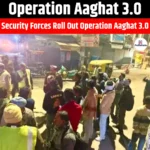Floods in Rajasthan
|
General Studies Paper III: Disaster Management, Environmental Pollution & Degradation |
Why in News Floods in Rajasthan?
Recently, heavy rains have triggered flood like situation across several parts of Rajasthan. Districts like Bhilwara, Kota, and Chittorgarh are facing waterlogging and many rivers have overflowed.
Key Highlights of Recent Flood-Like Situation in Rajasthan
- In July 2025, Rajasthan experienced very heavy rainfall, leading to flood-like conditions across several parts of the state.
- The rainfall recorded this season stands nearly 88% above the typical average, making it one of the heaviest in recent years.
- From June 1 to July 28 2025, the state recorded 369.79 mm of rainfall against the average 196.79 mm. This unusual increase in rainfall has disrupted normal life in both villages and cities alike.
- Districts such as Bhilwara, Kota, Jhalawar, Chittorgarh, Pali, and Sirohi are among the worst-hit.
- In Bhilwara’s Bijolia region, streets resembled rivers and a boat was seen moving through flooded roads. Water rose up to 5 feet over the Eru River bridge.
- In Chittorgarh, two people on a bike were swept away by the strong current while trying to cross the Bedach River bridge.
- In Jaipur, rainwater flooded roads and disrupted traffic across low-lying areas.
- Due to rising river levels, gates of major dams including those on Chambal, Kalisindh, and Banas rivers were opened to release excess water.
- The Novnera Dam in Kota, built under the ERCP project, released water through 13 gates for the first time since construction.
- Nearly 150 families from Kudaila village and around 100 people from Deolikurd in Ramganjmandi area were relocated to safer zones.
- Rajasthan’s Jaipur Meteorological Centre reported the highest rainfall in Ramganj Mandi (Kota) at 1,261 mm this monsoon season.
Flood-Prone Areas of Rajasthan
- Southern Rajasthan: Southern districts of Rajasthan receive more rainfall compared to the desert zones in the west. Udaipur, Banswara, Dungarpur, and Pratapgarh often face waterlogging and floods during monsoon months. The terrain causes rainwater to collect quickly in low-lying areas. Rivers like Mahi and Jakham overflow during continuous rains.
- Kota Region: The Kota division often sees both urban flooding and river-based floods. Districts such as Jhalawar, Baran, Bundi, and Kota usually receive significant rain from June to September. The Chambal River runs through this region. When water levels rise, dams like Kota Barrage and Rana Pratap Sagar gates must be opened. This creates a risk of downstream flooding.
- Eastern Rajasthan: Districts in eastern Rajasthan also face flood-like situations. Sawai Madhopur, Tonk, Dausa, and Karauli are some examples. Seasonal rivers including Gambhir, Morel, and Banas flow through these regions and rise quickly during the monsoon. When these rivers overflow, surrounding villages face floods.
- Hilly Terrain: Some parts of Rajasthan have hilly terrain. In such areas, water flows downhill rapidly during rain. This creates flash floods that damage roads and houses. Sirohi, Mount Abu, and Banswara are especially at risk.
|
Floods in India 2025
|
Also Read: Cyclone Dana
Causes of Floods in Rajasthan
- Natural Causes:
- Intense Monsoon Rainfall: Monsoon rains bring most of Rajasthan’s annual rainfall. In some years, the state receives sudden and excess rainfall within a few days. For example, in 2023, Rajasthan recorded over 100 mm of rain in 24 hours in several districts. When rain exceeds the soil’s absorption capacity, water begins to collect and causes flooding.
- Overflowing Rivers and Streams: Rivers like Chambal, Banas, Mahi, and Kalisindh flow through different parts of Rajasthan. These rivers rise quickly after continuous rainfall. Tributaries and seasonal rivers often overflow and spread water into nearby villages and farmland. In the monsoon months of July and August, river levels increase sharply. When dams and barrages are full, authorities must release water, which sometimes floods low-lying areas.
-
- Saturated Groundwater: In years of good rainfall, the groundwater table rises. When rain falls on already saturated ground, the soil cannot absorb more water. This leads to surface runoff, which travels fast in sloped areas. Flooding becomes worse in areas with rocky or clay soil, which resists water absorption.
- Poor Natural Drainage: Natural drainage in Rajasthan is limited due to the uneven terrain. Water gets trapped in valleys, depressions, and poorly connected lakes. When heavy rain continues, these spots become flood zones. In forested regions of southern Rajasthan, blocked natural streams also lead to sudden water surges.
- Anthropogenic Causes:
- Urbanization: As cities in Rajasthan grow, urban areas expand into natural catchment zones and floodplains. Builders construct homes, shops, and roads without considering water flow paths. As a result, water has no outlet during heavy rain. Cities like Jaipur, Kota, and Ajmer have seen urban flooding in recent years.
- Encroachment on Water Bodies: People have built colonies and farms around traditional lakes, ponds, and drainage channels. This restricts the natural movement of water. Encroachments have become a major reason for waterlogging in areas like Bhilwara, Tonk, and Chittorgarh.
- Land Degradation: Tree cover in southern Rajasthan has reduced over the years due to mining, construction, and farming. Without vegetation, the soil cannot hold rainwater for long. Water flows down faster, increasing the chances of flash floods. The lack of forest buffers also increases soil erosion.
- Irregular Weather: Changing climate patterns are making monsoon behaviour less predictable. Rainfall events are becoming more intense but shorter in duration. Some areas receive double the average rainfall in just a few hours. This sudden change puts stress on local infrastructure and drainage.
Also Read: WMO State of the Climate in Asia 2024 Report
Impact of Floods in Rajasthan
- Positive Impacts:
-
-
- Groundwater Recharge: Floods help recharge underground water levels in Rajasthan. The state depends heavily on groundwater for farming and drinking. When rainwater flows across fields and dry riverbeds, it seeps into the soil and fills underground aquifers. In 2023, parts of eastern Rajasthan showed a clear rise in groundwater levels after heavy monsoon rains.
- Improved Soil Fertility: Floodwater carries silt and minerals from riverbeds. When the water spreads over farmland, it deposits this fertile soil. This process improves land quality and supports better crop growth. Farmers in districts like Bundi and Baran have seen increased yield in crops such as paddy and maize after such floods.
- Better Irrigation Storage: Floods fill up dams, lakes, and reservoirs that supply water during dry months. In years like 2022 and 2024, large dams in Rajasthan reached near full capacity after monsoon floods. This stored water helped provide irrigation to fields in winter and summer.
- Negative Impacts:
- Damage to Life and Property: Floods damage homes, roads, schools, and shops. Many people lose shelter and belongings. Low-lying areas in cities face waterlogging for days. In rural districts, kutcha houses collapse easily.
-
- Crop Loss and Livelihood Disruption: Heavy floods destroy standing crops, especially during the sowing or harvesting season. Farmers suffer income loss and debt. Water remains in fields for days and spoils the soil. In 2020, floodwaters in Kota division ruined large areas of soybean and maize crops.
-
- Health and Sanitation Issues: Floods pollute water sources and create health problems. Dirty water mixes with the drinking supply and spreads diseases like cholera and dengue. Overflowing drains in cities lead to foul smell and unsafe conditions.
Flood Management in Rajasthan
- Dam Monitoring: Rajasthan has more than 690 dams across different districts. The Water Resources Department monitors water levels regularly during the rainy season. Engineers inspect dam conditions and plan timely water release to avoid overflow.
- Early Warning Systems: The state has improved its weather monitoring. The Meteorological Centre in Jaipur uses satellite data and radar systems to issue alerts. District collectors receive flood warnings when heavy rainfall is predicted.
-
- Disaster Response Teams: Rajasthan deploys State Disaster Response Force (SDRF) and Civil Defense teams in flood-prone districts. These teams carry boats, ropes, first-aid kits, and life jackets. During floods, they rescue people, deliver food, and shift families to safe shelters.
- Infrastructure Improvement Projects: The state is investing in better drainage and flood control systems. Cities like Jaipur, Kota, and Udaipur have launched projects to clean drains and build new culverts. In rural areas, small dams, bunds, and canals are being constructed to control water flow.
- Public Awareness: Local authorities organize workshops to train villagers and school children. These sessions teach how to respond during floods and stay safe. Volunteers support rescue operations and help identify risk zones. In 2025, the state launched the “Karmabhoomi se Matribhumi” campaign to involve local youth in water management and flood preparedness.









